The theme for 2014 is consensus, says Adam Button of ForexLive.com. There is an overwhelming consensus of analysts looking for the same things in the year ahead. We look at four crowded trades and cast a verdict on whether the groupthink will be proven right or wrong.
#4: The Euro Will Fall in 2014
Everyone loves to bet against the euro. When the Eurozone was in crisis, the doomsday euro-breakup crowd was screaming to sell. When Draghi said he would do ‘whatever it takes’ they mocked him. As 2013 began, there was talk about a fresh recession or political upheaval. What happened? The euro was the top performer in the year.
This time, it’s a new angle. The euro has been buffered by repatriation flows and is overbought. The ECB could unleash fresh LTROs or negative deposit rates and Germany could sputter. Even if Europe grows, the US is stronger and that will pull down EUR/USD.
Bloomberg surveyed 46 analysts about the euro in 2014 and the mean estimate was for a decline to 1.28—nearly 10 cents on the mean. Of the 46 analysts, 42 expected EUR/USD to decline next year. One outlier is Goldman Sachs.
“Tapering is in the price already, we find it difficult to see where the dollar strength would come from,” Stolper wrote in an e-mailed response to questions this week. “There is always a risk that stronger growth in the US suddenly pushes rates even higher as markets anticipate a stronger Fed response. However, our base case is that we see only marginal support for the dollar from interest rates.”
Stolper is a punching bag in the FX market for some dead-wrong calls but there is almost no one to trust when it comes to the euro. The one trend that’s guaranteed is that the consensus can’t be trusted; they’ve been wrong since the euro was launched.
So on one side you have the consensus, on the other it’s Stolper. Ugh. But wait, there’s a third option—technicals. There’s a double top forming in EUR/USD and that pattern could cast the deciding vote.
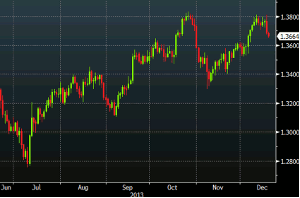
The Looming EUR/USD Double Top
Click to Enlarge
In the near-term, the bears have a technical catalyst to sell (BBVA is saying to do just that). The measured target of the formation is nearly 1.28 so the consensus could be proven right. The key level to watch is 1.3830, which is the double top. If that breaks, the pair will keep doing what it’s done for the past four years—proving analysts wrong.
#3: The Canadian Dollar Will Decline
The Canadian dollar had its moment in the sun. For years it was the darling of the currency market as Canadian banks sailed through the crisis and the economy sped along. In 2013, Carney left and the loonie lost its mojo, stumbling to a three-year low. Now analysts are piling on, with many saying it will fall another 5% to 1.1400.
The oldest, surest way to trade currencies is to follow central banks. As Australia’s central bank cut rates in 2013, the Australian dollar struggled. It finally found a bottom when policymakers signaled that cuts were no longer coming.
For the most part, analysts missed the trade in AUD but they feel like they have a second chance with the Canadian dollar. Shortly after the RBA went to the sidelines, the Bank of Canada shifted from a hawkish stance on interest rates to neutral. That change woke the hibernating CAD bears and the currency weakened more than 4%.
The BOC’s main worry is deflation, prices rose just 0.7% year-over-year in October and business investment hasn’t picked up the way Poloz expected when he got the job.
Now, David Rosenberg and Goldman Sachs are two of many market watchers who are saying to sell the loonie.
Here’s why they’re wrong. For one, deflation isn’t a Canada-only story. November Canadian CPI picked up to 0.9%, which is the exact same pace in the US PCE report. Second, it’s tough to be bullish on the United States but bearish on Canada. If US companies begin to invest or the US economy grows, it won’t take long to spill across the border.
The Bank of Canada story is overplayed. With the loonie already weakening, that will put upward pressure on prices and there is no realistic scenario where the BOC cuts as the US economy accelerates. The consensus is for no BOC rate hikes until at least late 2015. If the US economy accelerates this year, those hikes will come sooner.
NEXT PAGE: Will 2 More Consensus Beliefs Hold?
|pagebreak|We could see USD/CAD continue to rise in early 2014 but selling close to 1.10 will prove to be a much better trade than betting on 1.14.
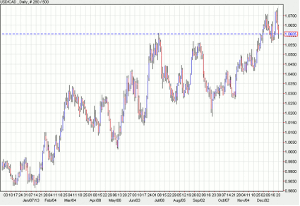
The Looming EUR/USD Double Top
Click to Enlarge
#2: Gold Will Continue to Decline
There will always be someone screaming to ‘buy gold’ so it’s impossible to get a consensus to sell but this is as close as it’s been in years, if not decades. The gold bugs have been humbled by a +25% loss last year and very few people are picking the bottom.
The problem is that the gold bull market over the past decade has been built on four factors:
1) Inflation
The belief: Runaway inflation was/is going to devalue everything except for hard assets and gold is the ultimate monetary instrument.
What happened: There is no inflation in the developed world because globalization is an incredible long-term deflationary event. If anything, lower prices remain a higher risk than inflation.
2) Deficits
The belief: Governments were on the way to insolvency. Creditors were nearing the point where they would no longer lend money to governments and that would create a death-spiral of insolvency.
What happened: Deficits are improving almost everywhere. Outside of the PIIGS, deficits never resulted in any significant bond market sell offs.
3) Tail Risks
The belief: The post-crisis world was so filled with political and economic risks that some type of unforeseen disaster was virtually inevitable. From war, to social upheaval—in a volatile world anything is possible.
What happened: Looking back over the past five years, it’s remarkable how stable the world has been. Even in devastated countries like Greece and Portugal, violence has been minimal. No one could have seen that coming but it points to more stability in the years ahead.
4) Money Printing
The belief: Central bank money printing along with currency wars would devalue all paper money.
What happened: They printed and printed and printed. The Japanese are still printing but the Fed has finally taken steps toward shutting down the printing presses. Whatever boost gold got from QE, it’s in the rearview mirror.
I look at those four factors as the four legs of the gold table and they’ve been cut out. The gold bulls will need to rebuild a framework for buying in the year ahead but not before prices decline further.
The first thing to watch is production. As prices fall, mines will close and that will put a floor under the gold market because of falling supply. There is talk that $1080 is a tipping point for many projects and I don’t expect to see a sustainable bounce until many headlines about shutdowns hit.
#1: Those Tempting Yen Technicals
For #1 on this list I could have put US dollar strength—it’s tough to find anyone who isn’t excited about the prospects for the US economy in the year ahead and that extends to the dollar.
Instead, I’ll give a nod to the technical analysts and the appetizing setups in the yen crosses—especially EUR/JPY, GBP/JPY, and USD/JPY. By almost any measure, the near-term moves in those pairs are overdone after seven-nine consecutive weeks of gains but those gains represent long-term technical breakouts.
The technicals are simple but that’s why there is such a strong consensus about further gains, likely after a retest of the break points.
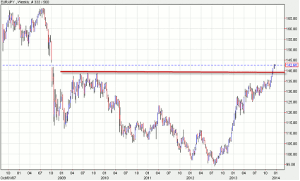
EUR/JPY weekly – has also cleared the 61.8% retracementp
Click to Enlarge
The bounce in GBP/JPY has cleared the 50% retracement but get another lift with a break above 61.8%.
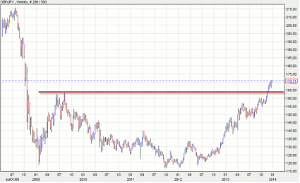
GBP/JPY weekly
Click to Enlarge
The measured target of the break of the wedge is above 110 in USD/JPY.
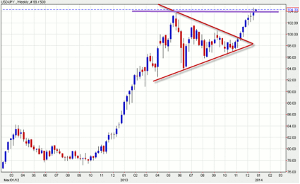
USD/JPY weekly
Click to Enlarge
Buying the yen crosses was the best trade in 2013 but the Bank of Japan and the government have plenty of unfinished business and would still like to see those crosses much higher as the battle against deflation and stagnation continues.
I think thousands of pips remain in longs as these pairs retrace the intense declines in the crisis. The key is the timing. Is a 200-pip retracement large enough to jump in, or do you wait for a larger decline?
These are already crowded trades as the CFTC positioning data shows but even periodic bouts of risk aversion have done little to shake out the longs. There are two trades, buy the dips or buy and hang on for dear life.
By Adam Button, Editor, ForexLive.com





















